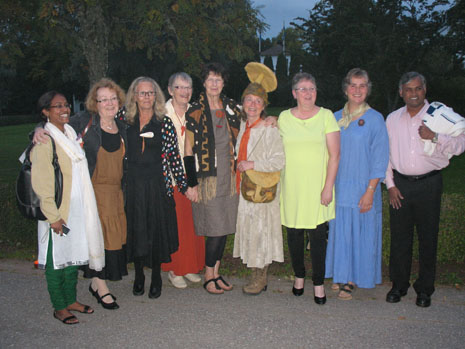14th International Fungi & Fibre Symposium 2010
By Carla Sundström
Natural dyeing with mushrooms has truly become international. This year's Fungi Fiber Symposium, in Gysinge, Sweden, had 90 participants representing 16 countries—11 European nations, as well as India, Australia, Iceland, Canada, and the USA. This created a wonderful base for exchanging new ideas, some of which will be presented in this article.


The global concern for the environment has rekindled interest of natural dyers in using eco-friendly resources. Our Indian guests, Sagarika Devi and Dr. K. Perumal, from the Shri Amm Murugappa Chettlar Reaserch Centre in Chennai, India, avoid use of chemicals to access insoluble pigments by extracting water soluble pigments from mushrooms and lower fungi . The team is engaged in the pilot-scale production of these mushroom pigments from Curvularia lunata, Alternaria alternata, Sclerotinia sp., Pestalotia sp. and Phoma foveata. Their goal is full scale environmentally acceptable commercial production. The photo below illustrates their color range on cotton.

Karin Tegener uses aluminum sulfate in combination with formic acid for cold mordanting, and is able to mordant five times as much wool than would be the case with traditional processes. Her method is to soak wool in a cold alum bath for four hours to allow a full chemical reaction with the alum. She then centrifuges and rinses the wool, collecting all the water and returning it to the mordent bath. Since the wool has only a limited number of points for the mordent to attach chemically there is maximum mordanting with a minimum of spill. The alum that is free from the chemical bonding is rinsed off and used again for the following mordant bath. Not only does this save energy by cold mordanting, but saves the environment by retrieving all spilled mordents used in the next mordant bath.

During the symposium we mordanted primarily with alum, but made test swatches with alum, zinc, copper, tin, iron and non-mordanted yarn. The two chemists at the symposium believe that, used judiciously, these mordants have a place in natural dye tradition. At the same time they agree that the recommended amounts in many mordant guides can be reduced by half, and water reused for a later mordant bath.
Hjördis Lundmark presented her findings about the blue pigments derived from Sarcodon, a large hedgehog mushroom. Originally classed by Swedes as two species it was reclassified long after by a Dutch mycologist as one species which gave blue or gray. One can understand how those of us who pick in the pine forests had difficulty explaining our radiant blue results to those who pick among the spruces where the Sarcodon with gray pigment grew. After much confusion amongst mushroom dyers because they produce different colors, it was DNA tested and found to be two species. Now they are again two species thanks to Hjördis who performed many dye experiments and habitat studies. Sarcodon imbricatus gives only gray colors, whereas Sarcodon squamosus, which contains thelaphoric acid, gives much desired blues. Now when we seek blue from Sarcodon squamosus we start by looking amongst the pines.

Days in Gysinge were very colorful with mushroom and fiber art exhibitions, field trips, workshops and lectures. One workshop about tanning fish skins showed once again that mushroom pigments take well to protein fibers as the finished hides ended up in a mushroom dye bath. Lotta Rahme has studied tanning of both fish skins and hides using primitive methods in several ethnic groups. The results are striking. Her books can be an inspiration for all of us.

Here are a couple of creative ideas to use: Barbro Wingård uses her knitting machine to make small squares to dye in differing baths. After dyeing the squares she rips them up and obtains a multicolored skein.


Our name tags were very special this year. Liza Johansson paints watercolors with pigments extracted from mushrooms. She cut slices of the birch shelf mushroom, Piptoporus betulinus, and painted texts with mushroom pigments. I proudly show my own name tag made by Liza for the symposium.

If this article has made you curious to learn more you can visit our home page at http://ifff2010.eu, google mushroom dyeing or come to our next symposium in early October 2012 at the foot of the Pyrenese Mountains in Spain.
 Turkey Red Journal
Turkey Red Journal
